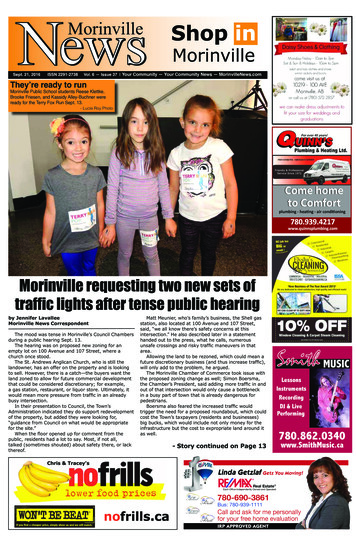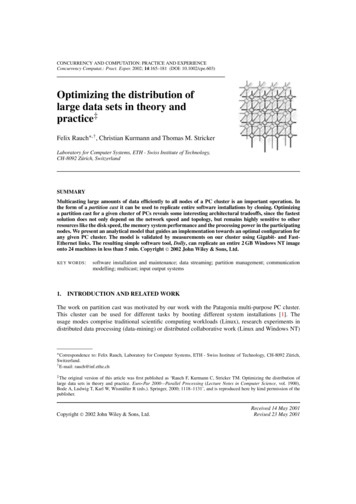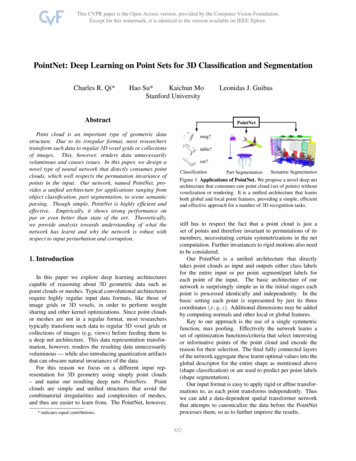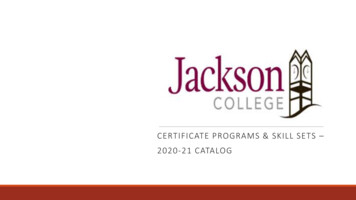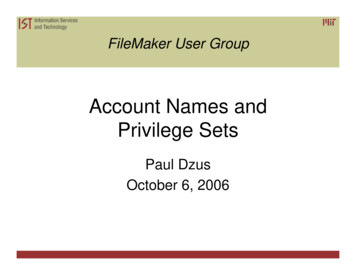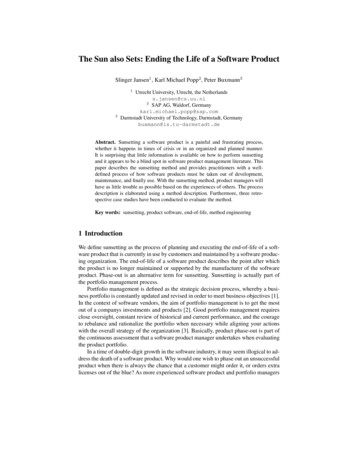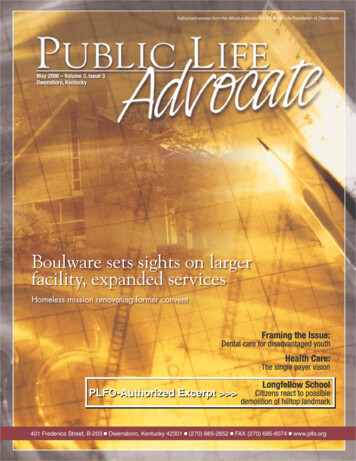
Transcription
Authorized excerpt from the official publication of the Public Life Foundation of OwensboroMay 2006 – Volume 3, Issue 3Owensboro, KentuckyBoulware sets sights on largerfacility, expanded servicesHomeless mission renovating former conventPLFO-Authorized Excerpt 401 Frederica Street, B-203 N Owensboro, Kentucky 42301 N (270) 685-2652 N FAX (270) 685-6074 N www.plfo.org
Longfellow SchoolCitizens react to possible demolition of hilltop landmarkBy Benjamin Hoak“Longfellow School the best of all / Sits on a hill so very tall ”For many Owensboro residents of a certain age, these openinglines of Longfellow School’s fight song stir memories of childhoodwhen they were full of promise, running up the hill to a building thatmust have seemed enormous.Back then, of course, it was just a school, the place where theyspent time between summers of freedom. Today, however, it’s part ofthe community’s history – which is why some former students andpreservationists are alarmed that it might be torn down.Owensboro Public Schools owns the two-story building that sitsjust north of Owensboro High School on the west side of FredericaStreet. By the summer of 2007, the school board plans to begin construction on a gymnasium that will fill the open space between Longfellow School and Owensboro High School. The question is whetherthe school board will decide to tear down Longfellow to build thenew gym or keep it and remodel the interior for another use. Currently Longfellow is used for ROTC programs, alternative to suspension programs, some extracurricular activities and storage.The question of whether to preserve Longfellow is part of a largerdebate in communities such as Owensboro about how far to go tosave historical landmarks, given financial limits and the needs of thefuture.In Longfellow’s case, “no decisions have been made yet,” saidPublic Life Advocate – May 200614Larry Vick, superintendent of the Owensboro Public School district.The school system is currently developing a facilities plan that muststill be approved by the state before any new construction can begin;the gym is already part of the plan, but other changes are prolongingthe process. Vick and school board member Nancy Eskridge said theboard won’t decide about Longfellow until the facilities plan is complete and the board has reviewed its architect’s recommendations.The school system has hired Sherman Carter Barnhart from Lexington to design the new gymnasium. The firm has experience inhistorical renovations and Eskridge said the school board asked it foroptions and expenses involved in both demolition and renovation ofLongfellow.Built like a bunker“It’s a beautiful old building,” Eskridge said. “I would love tokeep it.” She isn’t sure, however, that there will be a use for it becauseof the way it’s constructed.According to records at the Daviess County property valuationoffice, the building contains 36,974 square feet, has a foundation ofconcrete, is constructed of wood and brick, and is valued at 1.3 million.It has “a structure like a bunker,” said Gary Adams, secretary-treawww.plfo.org
Longfellow Schoolsurer of the Preservation Alliance of Owensboro-Daviess County.“It’s a solid building. It’s still in good shape.”Therein lies some of the difficulty – and expense – of renovating the building for new purposes. “The inside walls are reinforcedconcrete,” Vick said. “There’s very little potential for reconstruction.” Eskridge said the school system can’t use classrooms in thebuilding without an elevator available for disabled students andstaff, which it currently doesn’t have.She added that Longfellow can’t be easily redesigned, but “youcan do anything if you have enough money. It’s all tied to cost.What’s the cost to remodel against the cost to start over? We’restewards of the public’s money. We have to see what the architectscan tell us. If it does come down, what goes up in its place wouldlook just as nice if not better and satisfy the needs of OwensboroPublic School students for years to come.”Vick said the school system will probably continue using thebuilding at least until the new gym is completed.Joe Haycraft of Owensboro, a retired airline pilot who attendedthe school in the 1930s, still remembers the names of two of hisfirst teachers, Ms. Smitha and Ms. Lumpkin. “We need to keepbeautiful old buildings like this,” he said. “They’re the fabric ofour community.”Sue Haycraft, who is married to Joe, also went to Longfellowin first grade. “I believe in preservation for posterity and futuregenerations,” she said. “I’ve talked to all kinds of people who donot want it torn down. Even as a six-year old, it impressed me. I canremember the sun streaming in those windows.”*“Adaptive reuse”But a community often needs more than just memories to saveold structures. “We have torn down a tremendous amount of beautiful old buildings,” says architect Terry Blake of RBS Design Groupin Owensboro.Why? Not because no one remembered them, but because therewas no use for them any longer. If a building is to be saved, it mustA long historyhave a purpose.Preservationists and former students point out that LongfellowBlake is an advocate of what he calls adaptive reuse. It doesn’trepresents important history in the Owensboro community. Con- necessarily involve preserving structures exactly the way they werestruction began on the school in August of 1931 and was completed built; instead, old buildings such as Longfellow are adapted toin time for the spring semester beginningmodern standards while still maintainingJan. 25, 1932. According to a Jan. 17,the aesthetics of their past. “I would just1932, article in the Messenger-Inquirer,have to hope it could be considered (in“OurcontentionisyoushouldKey Bros. Construction of Murray, Ky.,Longfellow’s case),” he said. “We can’twas awarded the building contract in thehave disposable architecture anymore,”bend over backwards when yousum of 68,425. The company followedhe said. “We can’t afford to.”have a building of that characterthe design plans of William Butts Ittner,Blake believes it might be easier toa famous St. Louis architect who wasadapt the use of Longfellow if the buildand significance to try to findconsidered a national expert in elemening itself could be moved to another spota way to integrate it, even if ittary school design.on the same site. “It’s amazing what“The building is one of the most attechnology will do. There are some gicostsalittlemore,”hesaid.tractive of its kind,” the article read. Itant movers out there. You can move twocontained 11 classrooms on two floors,and three-story buildings, all masonry,”“Unless there’s a compellingas well as an auditorium that seated 400he said. It’s not necessarily cheap, hereason to get rid of a building of added. “But sometimes in the interest ofand was equipped with a booth for “moving picture purposes.” Each classroomheritage, it’s worth doing.”that character, why do it?”also had the capacity for moving pictureEskridge said the school board hasmachines. At the time, J.L. Foust (fornot considered the possibility of moving– Gary Adamswhom Foust Elementary was named)the building because no one has menPreservationAlliancewas superintendent of the city schools.tioned the idea to them.Members of the board involved withIndependence Bank, which is headthe new building included W.A. Steele,quartered in Owensboro, recently anJames H. Davis and W.R. Jagoe.nounced plans to undertake the kind ofAdams thinks officials should do everything they can to save adaptive reuse Blake describes. The bank is purchasing a historicalLongfellow. “Our contention is you should bend over backwards building on St. Ann St. across from the courthouse and renovatwhen you have a building of that character and significance to try ing it into a downtown branch of its operations. According to viceto find a way to integrate it, even if it costs a little more,” he said. president Larry Mayfield, officials initially wanted a new building“Unless there’s a compelling reason to get rid of a building of that that would have been a replica of historical American architecture,character, why do it?”similar to the bank’s other branches.When they saw the St. Ann St. building, though, they realizedFond memoriesthat it would retain the look of historical Owensboro while fitting inLongfellow was last used as an elementary school in 1975. with the look of their other buildings. The bank carefully weighedMany of its former students still reside in Owensboro and look cost options before deciding to proceed, Mayfield said. “We’ve gotback fondly on their elementary school days. “We still get togeth- to be good stewards of what we have,” he said. “We felt it probablyer,” said Ann McManus, who attended the school from first through would be a little more expensive to keep the old building, but wesixth grade, along with her sister, Marylou Steele, her sister-in-law, felt like it would be worth it as a token of what can be downtownMarge Hager, and Beverly Steele. “We know the fight song. I re- and as saving pieces of the past for the future.”member where we played baseball out in the yard. The hill behindit is where we all went sleigh riding. It was loads of fun. Most Historic downtowneverybody walked to school. I thought it was awfully far away, butWhile many historic buildings in downtown Owensboro haveit wasn’t.already been lost, plenty still remain to be saved. Daviess Fiscal“We have discussed it. We think it would be absolutely a terrible Court recently budgeted 200,000 to renovate the Smith-Wernerthing to tear it down,” she said.building at Second and St. Ann streets. Add in 31,000 from a citywww.plfo.org15Public Life Advocate – May 2006
Longfellow SchoolRenaissance grant, and according to county commissioner BruceKunze, the county will have enough to restore the rare iron façade onthe front of the building as well as rebuild the back wall and gut thebuilding in preparation for retrofitting.“It was a group decision that we felt the building was worthpreserving,” Kunze said. “Historically, it’s one of the most significantbuildings downtown. It’ll really be an interesting and attractive building. I think it gives the community . . . a lot of character, it makes itinteresting, makes it attractive to tourists.”Kunze predicts the downtown area is ready “to boom and explode with growth” and hopes restoration efforts will help attract newbusinesses. Kunze also has a personal interest in preserving local historical buildings. His father and grandfather were partners in a men’sclothing store downtown from 1937 to 1978. His grandfather beganworking at the Newberry-Wile building when he was 14 and workedin the same block for more than 70 years. “Because (the county)owns the buildings (i.e. Smith-Werner), because they are historicallysignificant, I think Fiscal Court has some responsibility to maintainthe buildings,” he said.If county government can get its own buildings in good shape,perhaps it can induce private investors to move their businesses intosuch buildings, thus creating the public-private partnerships thatseem so beneficial, Kunze said.Mike Wallace, who owns MediaWorks, an advertising firm inOwensboro, understands the importance of private investors. Hebought the building at 208 W. Third St. (two doors down from Colby’s Restaurant) a couple of years ago after keeping his eye on it fora long time. When the owner retired, he sold it to Wallace, who renovated it and moved his company to the facility. “It has really uniquearchitectural features to it,” he said. “It dates back to 1895 . . . itdidn’t have the attention a lot of the old buildings downtown need.“I do believe these old buildings are really part of a treasure,” hecontinued. “Without a doubt, they speak to our history. There aregreat stories behind every building.” His own building once served asa bank, and the basement served as a barbershop many years ago (it isone of only two walk-down basements in downtown Owensboro).From a bottom-line financial standpoint, it’s sometimes easierand more cost-effective to simply tear down old buildings and startfrom scratch, he said, but it doesn’t add much to the character andhistory of the community. Tax incentives and abatements help thoseinterested in preserving historical structures, but private investors areneeded. “We’ve got some buildings we’re close to losing if someonedoesn’t step up,” he said.Preserving HistoryThe Breedenbach Building in downtown Owensboro,restored by MediaWorks.Can they be saved?While buying and renovating historic buildings may be withinthe grasp of some private investors, many citizens can’t follow thatexample. They can, however, have a voice in helping to preserve thelandscape of their town, even with a building such as Longfellow.“We always listen to citizens,” Eskridge said, when asked if agroup of concerned residents could make a difference. “I’m sure itwould factor in. I’m not sure it would make the decision. Our responsibility is to the students. We have to do the right thing for the kids;that will be the right thing for the citizens. All of it will be done withthe public in mind. I wish there was some really easy solution. I’dlike to save it if we could; we need to have a use for it.”“Our board has made a real commitment to the past withOwensboro High School,” Vick added, saying that many communitieshaven’t saved their original city high schools. What the school boardhas to do now is decide “what will be necessary to keep OwensboroHigh School viable for the future,” he said.“It’s through our built environment we’re able to have identitywith our past,” Blake said. “The older I get, the greater value I putupon our past.” nPublic Life Advocate – May 200616The Smith-Werner building at Second and St. Ann streets willsoon be restored with the help of the Daviess County Fiscal Courtand a city Renaissance grant.www.plfo.org
remember the sun streaming in those windows.” “Adaptive reuse” But a community often needs more than just memories to save old structures. “We have torn down a tremendous amount of beauti-ful old buildings,” says architect Terry Blake of RBS Design Group in Owensboro. W

